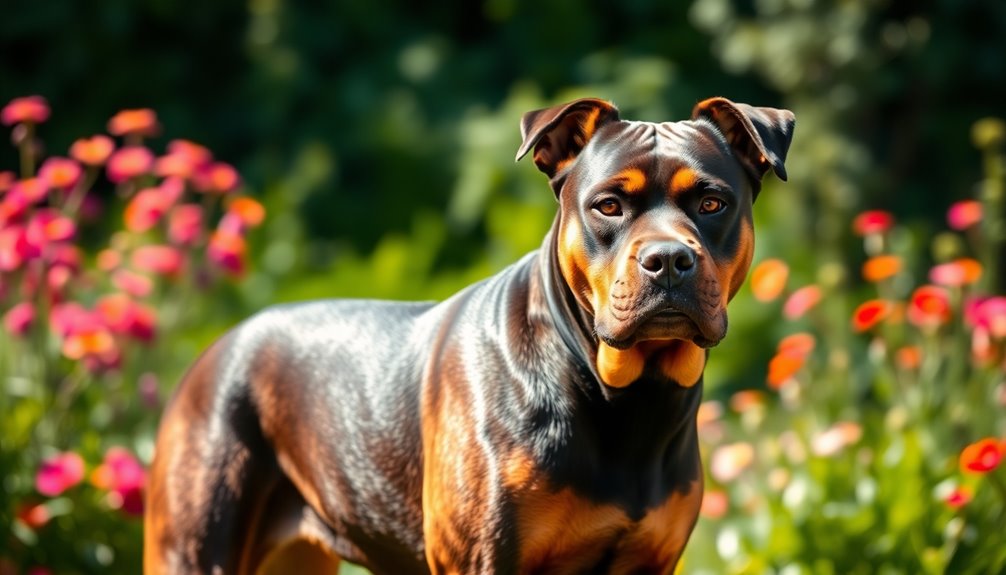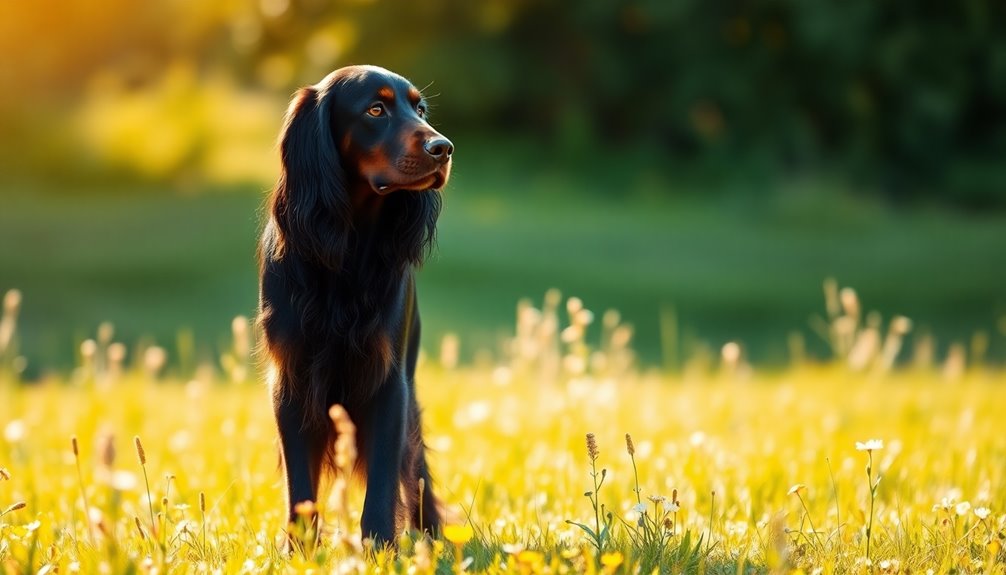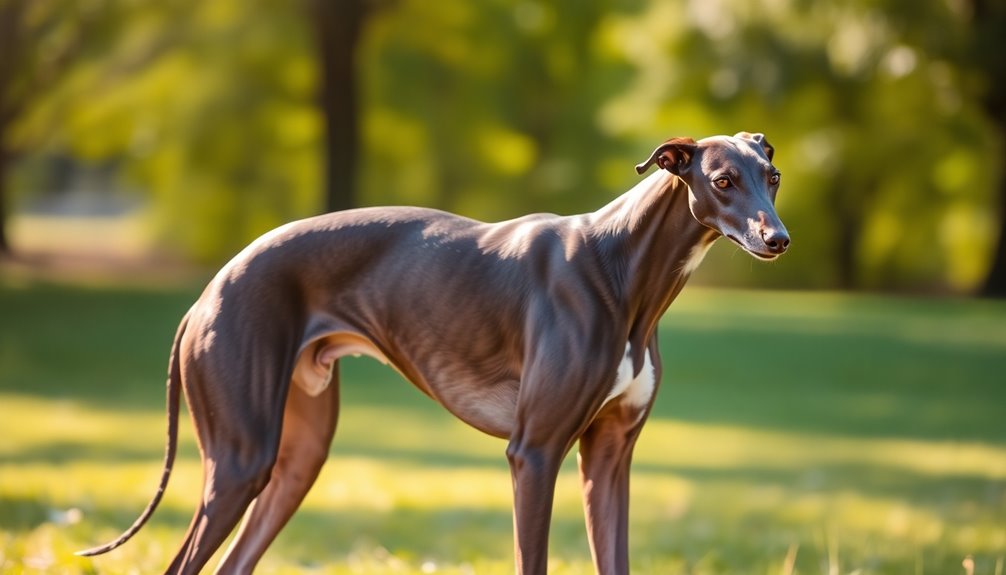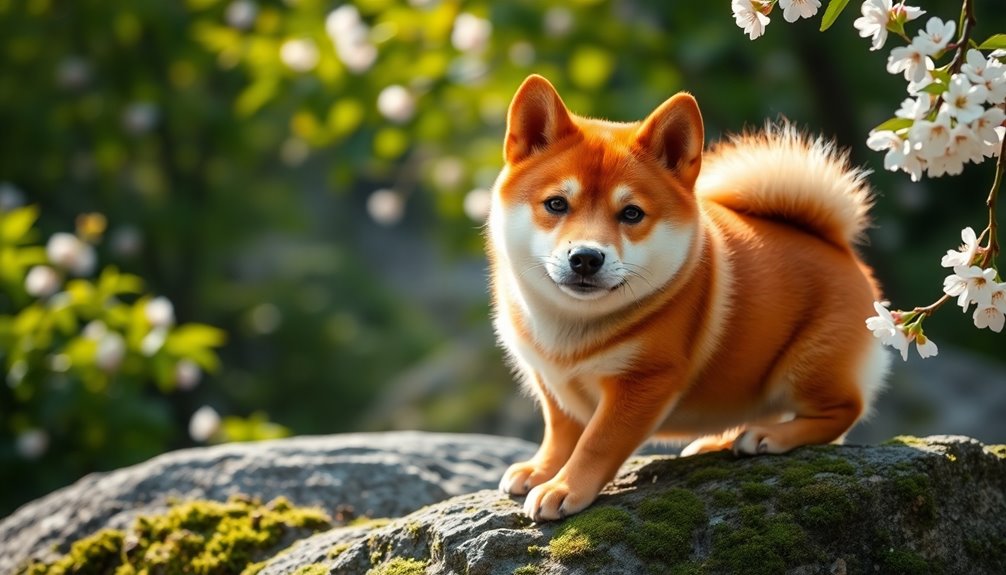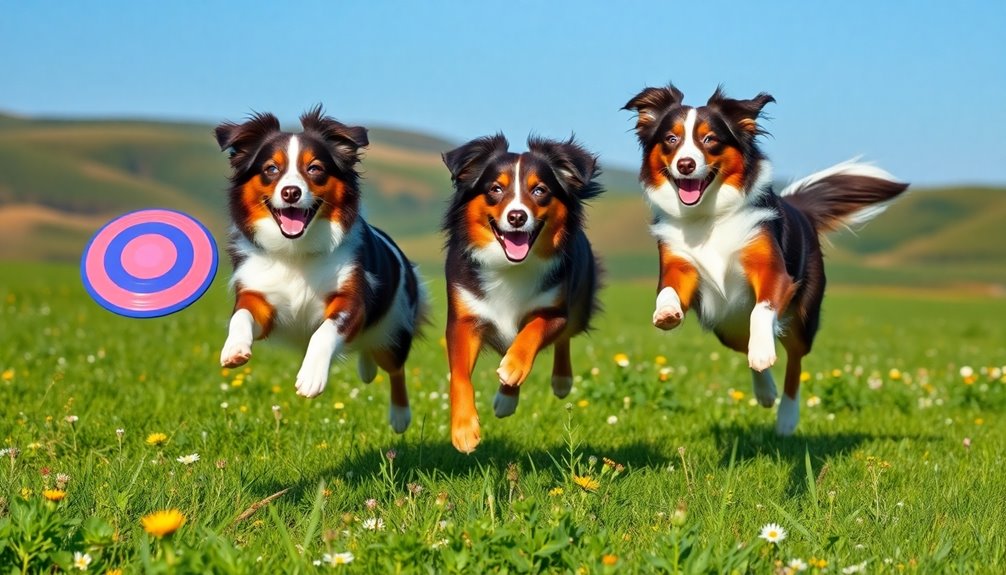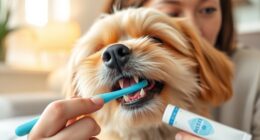Rottweilers are powerful and protective guardians, known for their loyalty and confidence. Weighing between 80 to 120 pounds, they have a muscular build and a strong jaw that boasts a formidable bite force. Their history as herders and protectors adds to their vigilant nature, making them alert to potential threats. Rottweilers form deep bonds with families, being gentle with children while remaining protective. However, they require proper training and socialization to manage their instincts. Their unique qualities make them remarkable companions. Stick around to uncover more about their health, training, and what makes them such exceptional dogs.
Key Takeaways
- Rottweilers possess a muscular build and imposing presence, making them effective guardians for homes and families.
- Their protective nature is paired with intelligence, allowing them to assess threats without unnecessary aggression.
- With a strong bond to their families, Rottweilers are loyal and gentle, especially with children.
- Early socialization is essential to balance their protective instincts while promoting friendliness towards other pets.
- Regular training and mental stimulation enhance their guarding abilities and overall behavior, ensuring a well-rounded companion.
Introduction
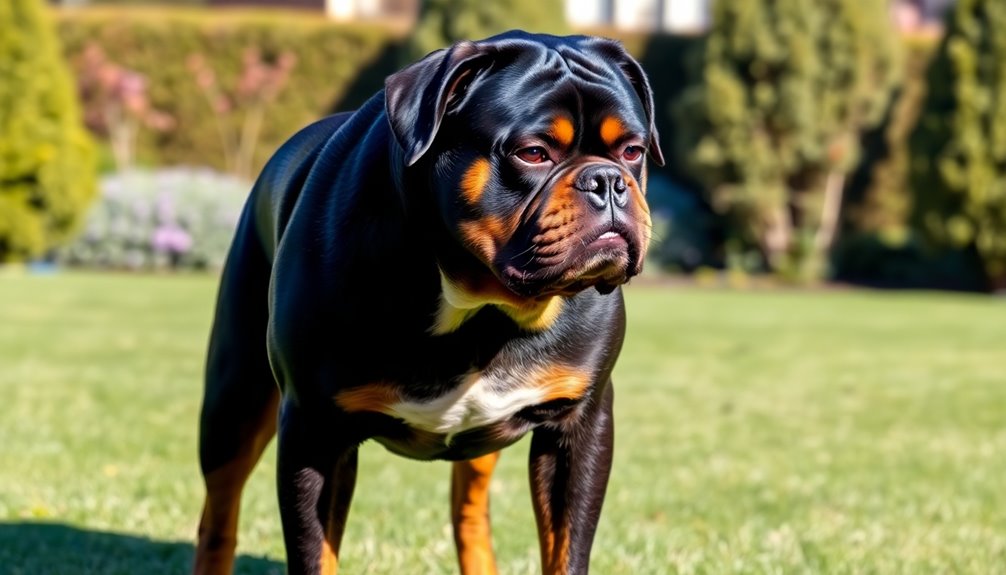
When you think of a Rottweiler, you might picture a strong and loyal guardian. These dogs are impressive, weighing between 80 to 120 pounds and standing 22 to 27 inches tall. Their robust, muscular build features a broad chest and powerful legs, giving them an imposing presence.
With big heads, tightly positioned and slightly hanging ears, Rottweilers have a distinctive look that commands attention. Their strong, square muzzles and medium-length, shiny coats—typically black with rust or tan markings—add to their striking appearance.
Rottweilers are known for their confidence and ability to act independently. However, they require extensive socialization and firm, patient training from a young age to channel their dominant tendencies appropriately. This breed is also highly trainable, making them suitable for various dog sports and activities.
While they can be protective and loving towards their families, especially children, it's essential to supervise interactions.
These dogs have high energy levels and need more than 40 minutes of exercise daily to stay healthy and avoid obesity.
With moderate barking and a low tendency to dig, Rottweilers excel in various dog sports, showcasing their intelligence and work capacity. Their loyalty and strength make them exceptional companions and guardians for those who invest in their training and care.
History and Origin
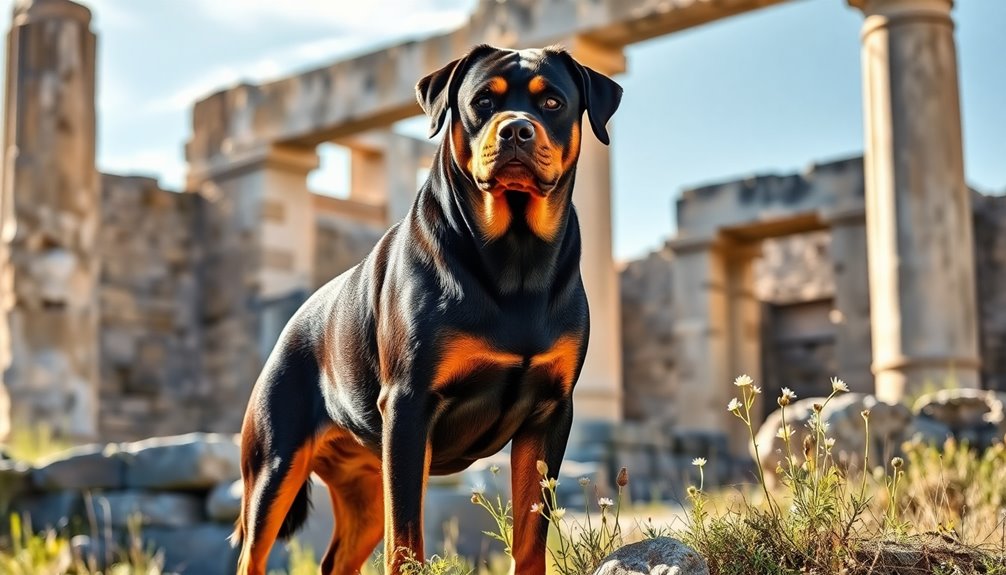
The Rottweiler's origin traces back to ancient mastiff-type dogs that traveled with Roman legions as they conquered Europe. These dogs were essential for driving and guarding cattle, ensuring both food supply and protection during military expeditions. As they settled in Rottweil, Germany, they became known for their strength and loyalty, laying the groundwork for the breed we recognize today. Over the years, Rottweilers have been recognized for their distinctive physical traits, further solidifying their status as a formidable breed.
Where and when the breed originated
Rottweilers trace their origins back to the Roman Empire, where their ancestors served alongside legions as protectors and drovers of cattle. These mastiff-type dogs journeyed over the Alps, helping to keep herds together and guarding them at night, especially given the lack of refrigeration during that time. This vital role led to the establishment of the town of Rottweil around 73 AD, which became a key location for the breed's development.
In Rottweil, the Roman drover dogs mixed with native breeds, resulting in a versatile canine. By the Middle Ages, these dogs were integral to the community, assisting farmers, butchers, and traders. They earned the nickname "Rottweil butcher's dogs," or "Rottweiler Metzgerhund," reflecting their important role in local commerce.
However, by 1900, Rottweilers faced a decline, with only one breeding female remaining in Rottweil. To prevent extinction, efforts were made to breed this female with similar Mastiff-like dogs. This led to the formation of the Deutscher Rottweiler-Klub in 1907, which aimed to promote working dogs and preserve the Rottweiler's lineage.
Interest in the breed surged leading up to World War I, as Rottweilers began to serve in police and military roles, marking the beginning of their modern revival.
Cattle Driving and Protection
Throughout history, Rottweilers have played a pivotal role in cattle driving and protection, showcasing their remarkable abilities as both herders and guardians. Originating from Roman drover dogs, they effectively drove and safeguarded cattle herds for Roman soldiers. In the German town of Rottweil, these dogs were essential for escorting cattle to market and guarding their owners. Bred by butchers for their skills, they became crucial in the mid-1800s cattle trading market.
When herding, Rottweilers employ a natural gathering style, using their strength and intimidating presence to control the herd. They often seek out the dominant animal, asserting their authority. Driving from behind is a common technique they utilize to keep the herd moving forward.
Their protective instincts shine as they guard property and livestock, utilizing forceful barks and charging when necessary. Over time, they develop bonds with the stock, showing affection as long as the herd follows their commands.
While technological advances like railroads nearly led to their extinction, the demand for Rottweilers surged during the World Wars for police work.
Today, they're recognized not only for their herding roots but also for their intelligence, size, and versatility as loyal family guardians.
Physical Characteristics
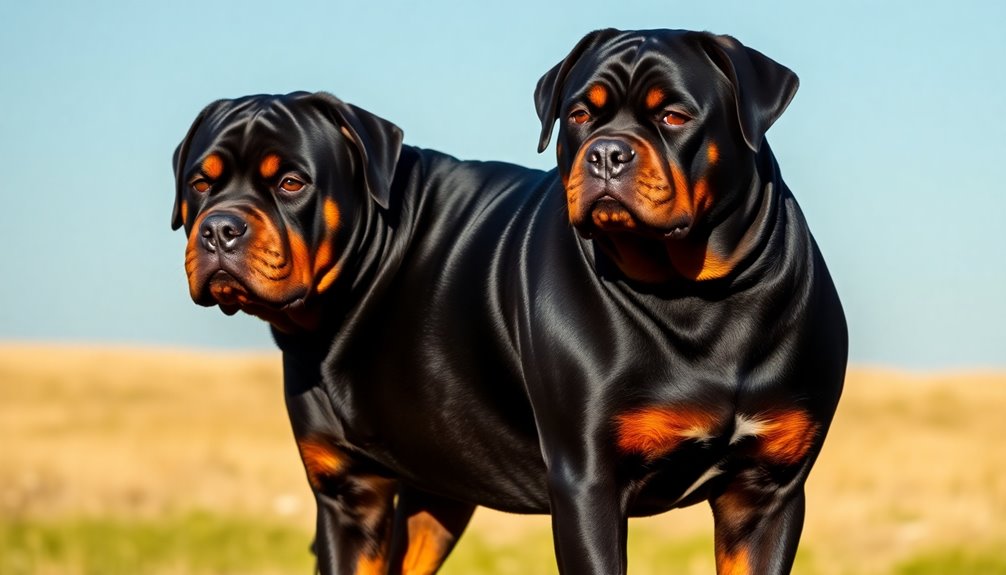
When you look at a Rottweiler, you can't help but notice its impressive size and solid build, weighing between 80 to 120 pounds and standing 22 to 27 inches tall.
Its striking black coat, accented by rust or mahogany markings, adds to its distinctive appearance. Additionally, Rottweilers typically exhibit specific color combinations that enhance their visual appeal.
You'll also see its strong jawline, which highlights the breed's powerful nature and contributes to its reputation as a formidable guardian.
Size, weight, and coat details
Standing tall and robust, Rottweilers exhibit impressive physical characteristics that set them apart. Males typically stand between 24 to 27 inches at the shoulder, while females range from 22 to 25 inches. By 22 months, they reach their full growth, although variations in height can occur due to breeding and genetics. Notably, genetics plays a significant role in determining the final size of Rottweilers.
When it comes to weight, male Rottweilers generally weigh between 95 to 135 pounds, while females weigh around 80 to 100 pounds. You'll notice significant weight gain in puppies between 2 to 4 months, starting from 11 to 17 pounds. Adult weight can fluctuate based on nutrition and overall health.
Rottweilers sport a short, dense, and glossy coat that's designed to provide protection in various weather conditions. While most Rottweilers have this standard coat, long-haired versions do exist, though they're less common.
The breed's coat is predominantly black, accented with well-defined rust-colored markings on the chest, muzzle, and legs. These markings not only enhance their appearance but also play a crucial role in breed identification, making Rottweilers unmistakable guardians.
Distinctive Features: Strong Jawline
Rottweilers are known not just for their size and strength but also for their distinctive strong jawline, which plays a significant role in their overall physical prowess.
Their robust skull features a medium-length and broad shape between the ears, complemented by a moderately arched forehead and well-developed occipital bone. The strong jaw muscles provide a solid foundation for their impressive biting strength, allowing them to exert a bite force of 328 pounds per square inch (PSI). Rottweilers have a notable bite force that surpasses that of many other breeds, enhancing their reputation as powerful guardians.
Both the upper and lower jaws are broad, supporting a full set of 42 teeth with a scissor bite, where the upper incisors closely overlap the lower ones. Despite this formidable bite, Rottweilers exhibit remarkable bite inhibition, showcasing their ability to control the force of their bite. This precision is essential for their historical roles as herders and guardians, and it continues to serve them well in modern police and military work.
It's also important to debunk the myth of "lockjaw." Rottweilers don't have a locking mechanism; their jaws are fully mobile, allowing for natural movement.
Understanding these features helps you appreciate the Rottweiler's strength and adaptability.
Temperament and Personality
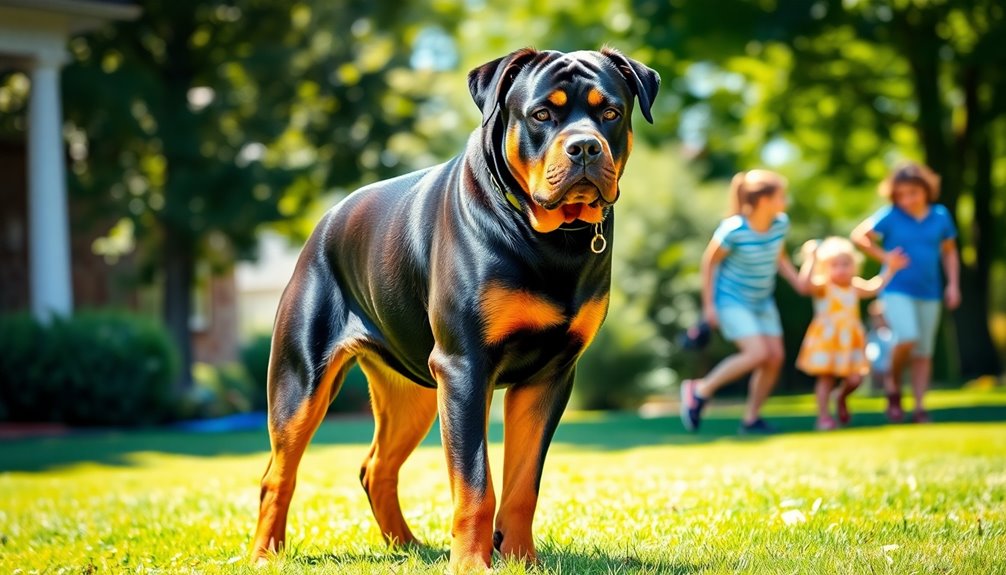
Rottweilers have a protective and confident demeanor that makes them excellent guardians for families and individuals alike. You'll find they're not only loyal companions but also adaptable to living with other pets when properly socialized. Understanding their temperament is key to fostering a loving environment where both you and your Rottweiler can thrive. Their powerful build requires responsible ownership and training to ensure they are well-adjusted and safe members of the household.
Protective and Confident Demeanor
With their powerful build and keen instincts, Rottweilers exude a protective and confident demeanor that makes them exceptional guardians. Rooted in history as guard dogs, these dogs are naturally vigilant and protective of their families and territory.
You'll notice this behavior manifesting through their alertness to unusual sounds or activities, often barking at potential threats and positioning themselves between you and strangers.
Rottweilers are known for their confidence and bravery. They fearlessly investigate perceived threats, using their strong and intimidating presence to deter intruders. Their intelligence allows them to determine what constitutes a real threat, which can be incredibly reassuring. This breed's ability to assess threats without unnecessary aggression sets them apart as effective guardians. Additionally, their loyalty and protective nature make them adaptable to various roles, including being wonderful family pets.
Loyalty and affection are also hallmarks of the Rottweiler temperament. They form deep bonds with their families, showing a gentle and loving nature when properly trained and socialized.
However, early socialization is crucial to balance their protective instincts with friendly behavior. Consistent training helps them distinguish between genuine threats and non-threatening situations.
With positive reinforcement, you can encourage calm and friendly behavior, ensuring your Rottweiler remains the protective guardian you desire while being a loving companion.
Suitability for families, individuals, or other pets
Finding the right fit for your household or lifestyle is essential when considering a Rottweiler. These dogs are loyal and loving, making them excellent companions for families. They're patient with children, and their protective nature grows as they bond with your family. However, keep in mind that Rottweilers need plenty of attention. If neglected, they may develop separation anxiety or exhibit destructive behavior.
For individuals, Rottweilers require owners who can spend time with them, as they can feel lonely when left alone for long periods. They need regular exercise and mental stimulation to thrive. If you're often away from home, a Rottweiler mightn't be the best choice. Additionally, Rottweilers thrive in environments where they receive plenty of exercise to remain level-headed and well-adjusted.
When it comes to other pets, Rottweilers can be variable in their compatibility. Early socialization is key to ensuring they get along with other dogs. While they may show a strong prey drive around smaller animals, proper introductions can help. Be mindful that unneutered male Rottweilers might display aggression toward other males, underscoring the importance of neutering and training. Overall, with the right commitment, a Rottweiler can be a fantastic addition to your family or home.
Health and Lifespan

When it comes to your Rottweiler's health and lifespan, understanding their typical life expectancy of 8-12 years is crucial. You should also be aware of common health concerns like hip dysplasia and heart problems that can affect them. Regular veterinary check-ups can help identify and address common health issues that impact their overall well-being.
Typical lifespan of the breed
Understanding the typical lifespan of Rottweilers reveals important insights into their health and well-being. On average, you can expect your Rottweiler to live between 8 to 12 years, with healthy individuals typically reaching around 8 to 10 years. While some Rottweilers have been known to live up to 14 years, this is less common. Compared to smaller breeds, Rottweilers have a shorter lifespan, which is consistent among larger dog breeds. Interestingly, female Rottweilers tend to live about two years longer than males, mirroring trends seen in human longevity. Most exceptionally long-lived Rottweilers are female, suggesting that gender may play a role in lifespan. Factors like genetics, breeding practices, and size significantly influence how long your Rottweiler might live. Overbreeding can lead to health issues that shorten lifespan, so responsible breeding is crucial. Regular veterinary check-ups, a balanced diet, and consistent exercise can help maximize your Rottweiler's lifespan. Regular screenings can also help detect genetic predispositions early, ensuring that any potential health issues are addressed promptly. While large breeds like Rottweilers generally face shorter lifespans, good care can make a meaningful difference in their overall health.
Common health concerns or genetic predispositions
While Rottweilers can live a fulfilling life of 8 to 12 years, their health can be impacted by several common concerns and genetic predispositions.
Joint issues are prevalent, with conditions like hip and elbow dysplasia causing pain and potential arthritis. You might notice symptoms like limping or difficulty placing weight on the hind legs.
Heart problems, including subaortic stenosis and cardiomyopathy, are also noteworthy. Regular heart screenings can help catch these issues early, allowing for better management.
Eye conditions such as progressive retinal atrophy and cataracts require regular veterinary check-ups to prevent severe complications.
Neurological concerns, including juvenile laryngeal paralysis and neuroaxonal dystrophy, can affect your Rottweiler's quality of life.
Additionally, Rottweilers face a higher risk of certain cancers, notably osteosarcoma, and serious conditions like bloat that need immediate attention. Proper training and socialization are essential in managing these health risks and ensuring your Rottweiler lives a long, fulfilling life.
Dental disease and obesity are common, impacting overall health, so maintaining a balanced diet and regular exercise is crucial.
Awareness of these issues can help you provide your Rottweiler with the best care possible, ensuring a healthier and happier life.
Tips for maintaining health and wellness
Maintaining your Rottweiler's health and wellness is essential for a long, happy life, and there are several key areas to focus on.
Start with nutrition: feed a high-quality diet tailored to your dog's age, rich in protein and fiber. Stick to a consistent feeding schedule and avoid giving human food, as some items can be harmful, like chocolate and onions. Monitor portions closely to prevent obesity.
Exercise is crucial, too. Aim for 1-2 hours of physical activity daily, adjusting based on your dog's age and health. Activities like walking, swimming, and fetch keep your Rottweiler fit while avoiding high-impact exercises that could stress their joints.
Don't forget to warm up and cool down before and after workouts.
Grooming and hygiene play a significant role as well. Brush your dog's coat regularly, bathe as needed, and maintain dental hygiene by brushing their teeth at least three times a week.
Schedule routine vet visits to catch health issues early, monitor weight, and ensure vaccinations are up-to-date.
Care Requirements
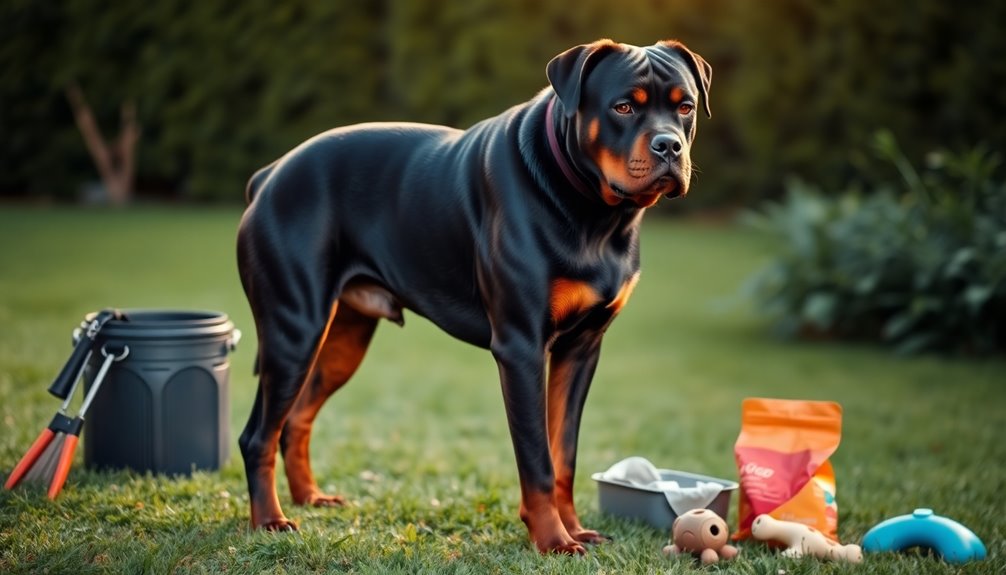
To keep your Rottweiler healthy and happy, you need to focus on grooming, exercise, and diet. Regular brushing helps maintain a shiny coat, while daily exercise meets their energy needs and prevents boredom. Additionally, providing a balanced diet is crucial for their overall well-being, so stick to high-quality food and avoid human snacks. Regular veterinary check-ups are also essential for monitoring their health and detecting any potential specific health issues.
Brushing Frequency for Optimal Coat
Brushing your Rottweiler regularly is crucial for keeping their coat healthy and vibrant. Aim to brush them at least once a week during normal periods. This routine helps remove dirt and loose fur while distributing natural oils, ensuring their coat stays shiny and robust.
Additionally, weekly brushing allows you to check for any skin issues or abnormalities, promoting overall health. Regular brushing also aids in managing shedding periods effectively, minimizing the mess in your home.
When shedding seasons hit in spring and fall, increase brushing to 2-3 times a week. Use an undercoat rake to effectively remove dead hair from their dense undercoat. Deshedding tools can also be invaluable during this time, helping prevent matting and reducing loose hair around your home.
For effective brushing, consider using a bristle brush to distribute oils, a pin brush for their double-layered coat, and rubber grooming mitts for daily maintenance.
After shampooing, using a dog-specific conditioner will keep their coat soft and shiny. You can even enhance their coat's health from the inside out with Omega-3 supplements.
Exercise requirements and energy levels
For a Rottweiler, regular exercise is essential to keep their energy levels in check and promote overall well-being. You should aim for at least 60 to 90 minutes of exercise each day, breaking it into multiple sessions to meet both physical and mental needs. A combination of walks, jogs, and playtime in secure areas keeps them active and engaged.
Incorporate activities like running, hiking, and fetch to satisfy their high energy levels. Games such as tug-of-war and agility courses offer comprehensive workouts, while training sessions and puzzle toys stimulate their minds. Consider introducing agility training or scent work for varied challenges that keep them motivated.
Remember, Rottweilers need mental stimulation just as much as physical activity. Engaging them with obedience drills, trick training, and rotating toys will help prevent boredom. Short, frequent training sessions maintain their attention and enthusiasm, reducing the likelihood of unwanted behaviors like excessive barking or chewing. Additionally, socialization is crucial to prevent aggressive tendencies and help them adapt to varying situations.
Lastly, early socialization is vital. Exposing your Rottweiler to different people and environments helps balance their protective instincts with friendly behavior. This ensures they can discern genuine threats from non-threatening situations, promoting positive behavioral development.
Feeding tips and diet recommendations
A well-balanced diet is crucial for keeping your Rottweiler healthy and strong. Focus on high-quality protein as the primary ingredient, such as real meat from beef, chicken, turkey, lamb, or fish.
For adult Rottweilers, protein should make up 22-26% of their diet, while puppies need 28-32%. This protein supports muscle development and overall health.
Healthy fats are also essential for energy and coat health, making up 12-16% of an adult's diet and 14-18% for puppies. Incorporate omega-3 and omega-6 fatty acids for optimal skin and coat condition.
When it comes to carbohydrates, keep them low and avoid fillers like corn and soy. Instead, opt for complex carbs like brown rice, sweet potatoes, and quinoa, along with some vegetables and berries for fiber and antioxidants.
Finally, ensure your Rottweiler gets a variety of vitamins and minerals for overall wellness. Calcium and phosphorus are vital for strong bones, and natural supplements like ginger or turmeric can support joint health. Regular veterinary check-ups are also essential for monitoring health and addressing any emerging issues.
Training and Socialization
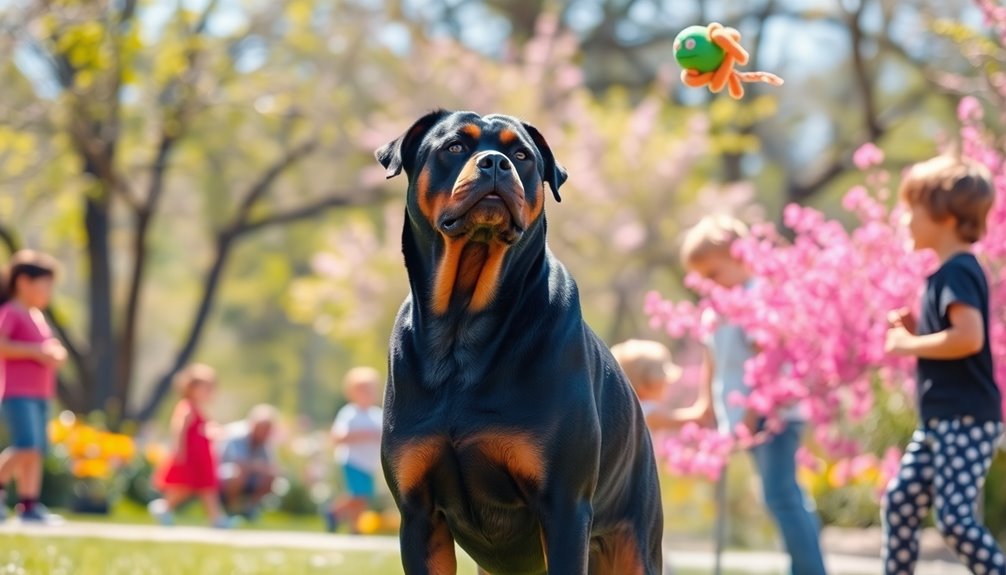
Training and socializing your Rottweiler is essential because they're highly intelligent and eager learners. Start with gradual exposure to new environments and different people to help them build confidence. It's also important to address any leash aggression towards strangers early on, ensuring they're well-adjusted and friendly. Establishing strong leadership during these initial interactions will further enhance their adaptability and social skills.
Highly Intelligent, Eager Learner
Rottweilers' intelligence makes them one of the most trainable breeds, capable of quickly mastering new commands and skills. Their natural smarts rank them highly in responding to cues and instructions, making training sessions both effective and rewarding.
To keep your Rottweiler engaged, use operant conditioning, starting with positive reinforcement. Reward desired actions with treats, toys, or praise to foster a positive learning environment.
Keep training sessions short—ideally around five minutes—to maintain your dog's attention and enthusiasm. Consistency is crucial; use clear commands like "sit," "down," and "stay," and repeat them regularly to reinforce learning. Obedience training should focus on compliance, not just tricks, ensuring a strong dog-owner relationship.
Engaging your Rottweiler in various activities can prevent boredom, which may lead to problem behaviors. Incorporate obedience drills, trick training, and interactive toys into your routine.
Activities like agility training or scent work provide both physical exercise and mental stimulation, keeping your dog focused and happy.
Gradual Exposure to New Environments
Socialization is essential for ensuring your Rottweiler becomes a well-adjusted and confident adult. Start this process between 3 and 14 weeks of age, as this is a critical window for introducing new experiences. Gradually expose your puppy to various sights, sounds, textures, and smells in a controlled manner.
Keep these sessions short and frequent to avoid overwhelming them, and always monitor their body language to ensure they're comfortable. If your puppy shows signs of stress, remove them from the situation and try again later.
Introduce your Rottweiler to different environments, like walks in diverse neighborhoods or visits to pet-friendly stores. Don't forget to expose them to household appliances and everyday objects to build their confidence. Quality interactions are prioritized over quantity for effective socialization, ensuring your puppy receives the best possible experiences.
Use background noise recordings of challenging stimuli, like fireworks, starting at low volumes to ease them into the experience.
Encourage social interactions with people of all ages and backgrounds. Begin in familiar settings and gradually introduce strangers. Teach your Rottweiler to greet people calmly with commands like "sit" to promote polite behavior.
This gradual exposure sets a strong foundation for their adaptability and helps them distinguish between genuine threats and safe situations.
Leash Aggression Towards Strangers
Even with proper socialization, some Rottweilers may still develop leash aggression towards strangers. This behavior often stems from frustration, as the leash restricts their natural ability to interact. You might notice your dog lunging, barking, or growling when encountering unfamiliar people.
Understanding the difference between leash frustration and genuine aggression is essential; often, the motivations behind the behavior are rooted in anxiety rather than true aggression. Leash reactive dogs typically exhibit calm behavior when off-leash, which can highlight the impact of being restrained.
To address leash aggression, focus on training strategies that promote attention and control. Reward your dog for paying attention to you during walks, using treats and praise. If your dog pulls, avoid tugging back; instead, turn around and walk in another direction to regain control.
It's also crucial to manage social interactions. Allow your Rottweiler to meet new people gradually, reinforcing calm behavior with treats.
Early socialization is key. Enroll in puppy classes and set up controlled playdates to help your dog differentiate between genuine threats and non-threatening situations.
Incorporate commands like "leave it" or "quiet" to redirect their attention when needed. By consistently applying these techniques, you can help your Rottweiler navigate their world with confidence and reduce leash aggression.
Ideal Living Environment
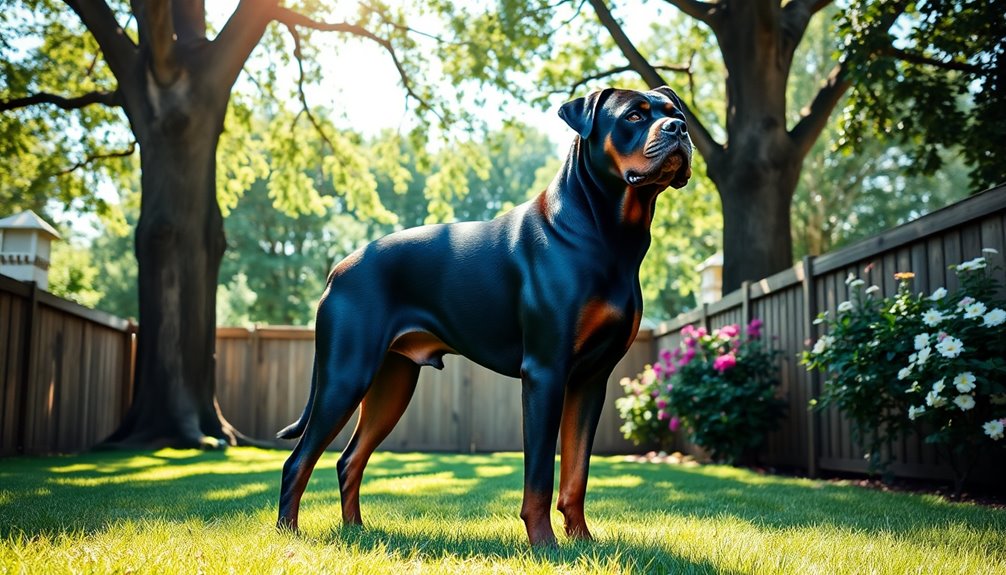
If you're considering a Rottweiler, a house with secure fencing is crucial to keep them safe and contained. These dogs thrive in moderate to cold temperatures, so ensure they've a comfortable indoor space during extreme weather. Additionally, providing consistent exercise is essential to keep your Rottweiler physically and mentally stimulated. It's also important to be aware of common behavioral challenges that may arise, as understanding these can help you create a more harmonious living environment. With the right environment, you'll help your Rottweiler flourish and bond with your family.
House With Secure Fencing
A secure fence is essential for creating an ideal living environment for your Rottweiler. To keep your dog safe and contained, the fence should be at least 6 feet tall. This height prevents jumping while allowing your Rottweiler to see outside.
Avoid sharp edges or protruding wires that could cause injury, and choose a smooth surface to make climbing more challenging. You might consider adding a coyote roller or fence extension for extra deterrence. Additionally, since Rottweilers are known for their strong protective instincts, they may be more likely to try to escape if they feel threatened. It's important to ensure the fence complies with local regulations regarding pet containment.
Durability is key, so opt for sturdy materials like wood, vinyl, or metal. Solid panel fences provide privacy and security, while metal fences should be designed to prevent climbing.
Make sure your fence can withstand your dog's strength and the elements. Prevent digging by installing barriers or dig guards at the base of the fence. Regularly check for and fill any potential dig sites.
It's crucial to ensure there are no gaps in the fence, as these can pose safety risks. A solid panel fence minimizes gaps, reducing escape risks. Additionally, privacy reduces visual stimuli that might agitate your Rottweiler, promoting mental well-being.
Temperature Tolerance: Moderate to Cold
Creating a secure environment for your Rottweiler also involves ensuring their comfort in varying temperatures. These dogs thrive best in moderate climates, thanks to their double coat that provides some insulation. While they can handle temperatures above 40 degrees Fahrenheit with little monitoring, you should keep a closer eye on them as it dips below that mark. Rottweilers possess a natural resilience to cold, which is a trait inherited from their German ancestry.
Below 20 degrees Fahrenheit, outdoor time should be limited, as it can become dangerous. For optimal care, provide a warm shelter and restrict time outside during frigid days. Consider using a dog coat in extremely cold weather, especially for young puppies and aging Rottweilers, who are more vulnerable to temperature extremes.
If your Rottweiler spends time outdoors in winter, ensure they've access to fresh water and a well-insulated doghouse. Monitor their diet, as a natural diet with plenty of liquids might be necessary for those living outside during cold months.
Regular veterinary check-ups are key to ensuring your Rottweiler's health in varying temperatures. By taking these precautions, you can help your powerful guardian remain comfortable and safe, regardless of the weather.
Famous for Their Loyalty
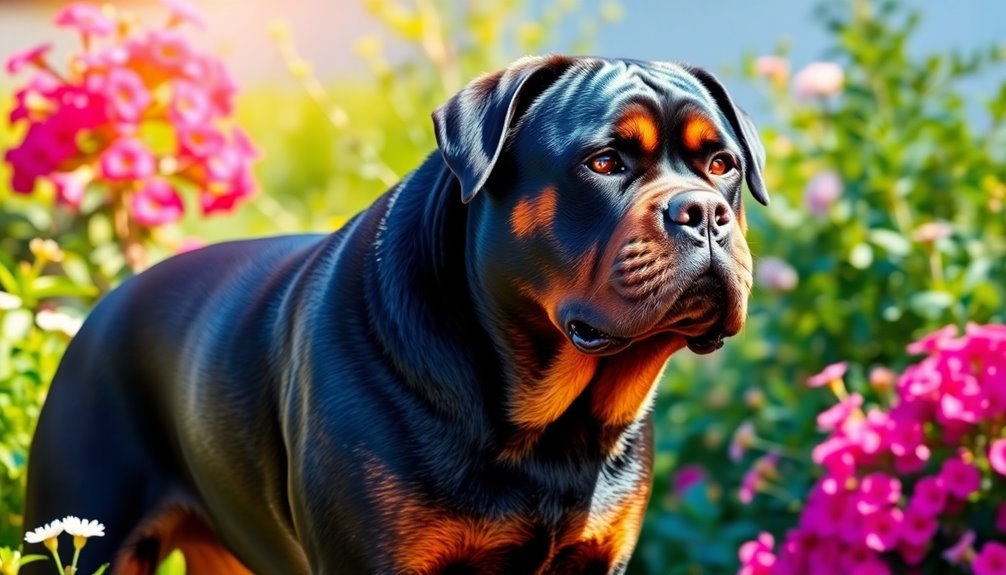
When you think about Rottweilers, their loyalty often stands out. Originally bred as versatile working dogs, these loyal companions have made their mark in popular culture, even appearing in films like "The Omen." Their unwavering devotion to their families is a testament to their rich heritage and protective instincts. Additionally, their strong protective instincts ensure that they take their guarding roles seriously, providing a sense of safety for their loved ones. Rottweilers are also known for their intelligent obedience, which allows them to excel in training and various working roles.
Versatile Working Dog Heritage
Rottweilers embody loyalty, a trait deeply rooted in their versatile working dog heritage. These dogs trace their lineage back to ancient Roman drover dogs, which herded livestock and protected soldiers as they traveled across Europe. As they accompanied Roman legions into southern Germany, their dependability and intelligence became apparent. Their ancestors were crucial in keeping herds together and guarding them at night, showcasing their protective instincts.
In medieval Germany, Rottweilers gained further recognition in the town of Rottweil, where they were known as Rottweiler Metzgerhund or "Butchers' Dogs." Traveling butchers relied on them to guard money pouches and pull meat carts, solidifying their reputation for loyalty and strength. This breed was named after a significant trade center for cattle in Germany, emphasizing their role in commerce and protection.
The demand for Rottweilers surged during World War I, as they took on roles as police and guard dogs. The formation of the Deutscher Rottweiler-Klub in 1914 helped standardize the breed. Today, Rottweilers excel in various roles, including service dogs and obedience competitors. Their adaptability, intelligence, and strong-willed nature make them not only excellent guardians but also beloved family pets, thriving on companionship and regular exercise.
Rottweiler in "The Omen
In the realm of horror cinema, "The Omen" stands out for its chilling narrative, yet it surprisingly lacks any portrayal of Rottweilers, a breed often associated with loyalty and protection.
While the film dives deep into the sinister rise of the Anti-Christ through the Thorn family's eyes, you won't find any Rottweiler characters enhancing the tension or drama.
The absence of Rottweilers in "The Omen" might lead to misconceptions about their role in horror. Despite their reputation for being fierce guardians, the film doesn't feature these dogs at all.
Instead, the plot revolves around supernatural events and family turmoil, leaving no room for protective canines.
You might expect Rottweilers to embody the loyalty and strength typical of their breed, but this film doesn't showcase any of those traits. Their natural protective behavior enhances their reputation as loyal companions, making their absence even more notable.
In fact, the narrative focuses solely on the human characters and their eerie experiences, neglecting to highlight any dogs as loyal companions or protectors.
Ultimately, "The Omen" disregards the powerful image of Rottweilers, missing an opportunity to integrate their remarkable characteristics into its haunting storyline.
Can You Handle Their Strength?
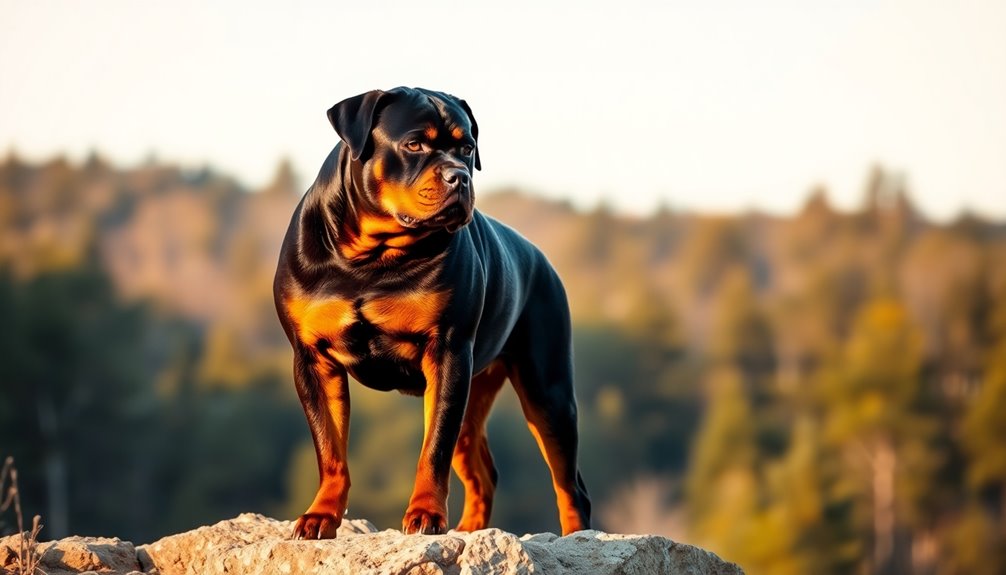
Owning a Rottweiler isn't for everyone; it requires experience and a strong commitment to training.
Their impressive strength demands that you provide consistent guidance and leadership to ensure they're well-behaved. Bullet point lists can be a helpful tool for organizing training goals and tracking progress.
If you're up for the challenge, you'll find a loyal companion who thrives under skilled management.
Ideal for Experienced Handlers
Handling a Rottweiler's strength requires more than just physical capability; it demands a confident and experienced approach. These dogs possess considerable muscle mass and a powerful bite, which can be challenging for someone without prior experience. Their compact yet substantial build, combined with their dominant tendencies, means they need a handler who understands their behavior and can provide firm leadership.
Rottweilers thrive on physical activity and require 1-2 hours of daily exercise to stay healthy and happy. This includes a mix of walks, jogs, and playtime, as well as mental stimulation through training sessions. Additionally, their ancestors were originally known as butcher dogs, which underscores their strong working instincts.
As an experienced handler, you must ensure they get ample outdoor time to engage in activities like running and swimming. Socialization is also crucial. Rottweilers can be cautious with new experiences and require consistent interaction with other dogs and people to develop a well-rounded temperament.
Their strong protective instincts make them excellent guardians, but this also means you need to manage their reactions to perceived threats. Without the right experience, their natural guarding behavior can become overwhelming. Taking on a Rottweiler means being prepared for the responsibility their strength demands.
Training Commitment Required
Taking on a Rottweiler means committing to a rigorous training regimen that matches their strength and intelligence. Start training early, ideally around 8-10 weeks, to curb their natural tendencies and enhance socialization. Early training is crucial for building obedience, so get started as soon as you bring your puppy home.
Use positive reinforcement techniques, like treats or praise, to encourage good behavior and maintain their focus during short, 5-minute training sessions. Consistency is key, so provide clear cues and avoid punishment; it only leads to unwanted behaviors. Rottweilers are known for their natural guarding ability, making it essential to instill appropriate responses during training. Additionally, the use of social engagement can further improve their training outcomes.
Socialization helps your Rottweiler behave well around others, while boundary training teaches them about their territory. Daily walks around the perimeter and using a long tether can reinforce their understanding of ownership.
As your Rottweiler matures, consider advanced training in areas like agility or protection work. This includes teaching them when to guard and how to respond appropriately.
Observe trained dogs to motivate your Rottweiler. With your dedication and commitment, you'll not only harness their strength but also cultivate a loyal and well-behaved guardian.
Frequently Asked Questions
Are Rottweilers Good With Children and Other Pets?
Rottweilers can be good with children and other pets when properly trained and socialized.
They're affectionate and protective but may accidentally bump into small kids due to their size. Supervision is key during playtime.
Rottweilers tend to get along well with dogs of similar energy levels, so introducing them to other pets at a young age helps foster a positive relationship.
Always ensure interactions are monitored for safety and harmony.
How Much Exercise Does a Rottweiler Need Daily?
A Rottweiler needs about 1.5 to 2 hours of exercise daily. You can break this into multiple sessions, incorporating walking, running, and swimming to keep things interesting.
Don't forget mental stimulation, too—obedience training and puzzle toys can keep their minds sharp. Gradually build up to high-impact activities, ensuring they stay healthy and happy.
Regular exercise not only maintains their physical fitness but also strengthens your bond with them.
What Is the Average Lifespan of a Rottweiler?
The average lifespan of a Rottweiler typically ranges from 8 to 12 years, with female Rottweilers often living about 2 years longer than males.
Factors like genetics, diet, exercise, and regular vet visits play crucial roles in their longevity.
Keeping your Rottweiler healthy through proper nutrition and weight management can help extend their life.
Be aware of common health issues, as early detection can significantly impact their overall well-being and lifespan.
Do Rottweilers Shed a Lot of Fur?
Yes, Rottweilers do shed a moderate amount of fur.
You can expect heavier shedding during spring and fall, as they go through two main shedding periods each year.
While their shedding isn't as intense as breeds with double coats, it can still spread dander, which might trigger allergies.
Regular brushing and grooming can help you manage their shedding effectively, keeping your home cleaner and your Rottweiler's coat healthier.
How Can I Calm a Hyper Rottweiler?
To calm a hyper Rottweiler, start by providing ample exercise and mental stimulation.
Engage in high-energy activities like running or fetch to burn off excess energy. Incorporate obedience training and interactive toys to keep their mind busy.
Consistent positive reinforcement helps reinforce desired behaviors.
Additionally, ensure your dog gets proper socialization and a balanced diet.
With patience and routine, you'll see a calmer and more focused companion.
Conclusion
In conclusion, Rottweilers are powerful guardians known for their loyalty and protective instincts. With the right training and socialization, you can nurture their natural strengths while ensuring they thrive in your home. Remember, they need an active lifestyle and a loving environment to flourish. If you're ready to embrace their energy and commitment, you'll gain a devoted companion who'll stand by your side through thick and thin. Are you prepared to handle the strength of a Rottweiler?

